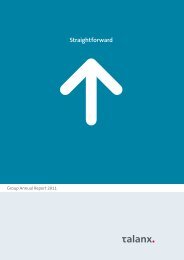Values
Values
Values
Create successful ePaper yourself
Turn your PDF publications into a flip-book with our unique Google optimized e-Paper software.
94<br />
Group Financial Statements<br />
Notes<br />
Financial Assets<br />
Financial assets are broken down into the following categories<br />
and sub-categories:<br />
• Held-to-maturity investments<br />
• Available-for-sale fi nancial assets<br />
• Recognized in income at fair value<br />
- Non-derivative and derivative fi nancial assets held for<br />
trading<br />
- Financial assets initially recognized at fair value through<br />
profi t or loss<br />
- Derivative fi nancial assets used in hedging relationships<br />
• Loans and receivables<br />
- Originated loans and trade account receivables (loans and<br />
receivables)<br />
- Cash and cash equivalents (loans and receivables)<br />
If the trade date and the settlement date are diff erent, the settlement<br />
date is applied for the purposes of initial recognition.<br />
Held-to-maturity investments:<br />
If the Company intends to hold fi nancial instruments to maturity,<br />
they are measured at amortized cost using the eff ective<br />
interest method.<br />
Available-for-sale fi nancial assets:<br />
Th e available-for-sale category primarily includes current and<br />
non-current securities and equity investments not classifi ed<br />
as held-to-maturity investments or at fair value through profi t<br />
or loss.<br />
In accordance with IAS 39, available-for-sale securities are<br />
measured at their fair value at the balance sheet date to the extent<br />
this can be reliably measured. Otherwise these are carried<br />
at amortized cost. Th e resulting unrealized gains and losses,<br />
including deferred taxes, are taken directly to equity. However,<br />
permanent impairment losses are recognized in profi t or loss.<br />
Th e unrealized gains and losses taken directly to equity are<br />
recycled in profi t or loss when the respective assets are sold.<br />
If fair value cannot be measured, the corresponding equity<br />
investments and securities are either carried at cost or measured<br />
on the basis of estimated discounted cash fl ows.<br />
Non-derivative and derivative fi nancial assets held for trading:<br />
As a rule, this category includes derivatives that do not meet<br />
the formal requirements of IAS 39 for hedge accounting. Th ey<br />
are measured at their fair value. Gains or losses from changes<br />
to the fair values are recognized in income.<br />
Financial assets initially recognized at fair value through profi t<br />
or loss:<br />
Th is category contains fi nancial assets that were classifi ed as<br />
initially recognized at fair value through profi t or loss. Th ese are<br />
fi nancial instruments that include one or several embedded<br />
derivatives that cannot be valued separately. Changes in fair<br />
value are recognized in the other fi nancial result.<br />
Derivative fi nancial assets used in hedging relationships:<br />
Th is category comprises all derivatives that fulfi ll the formal<br />
requirements of IAS 39 for hedge accounting. Th ey are carried<br />
at their fair value.<br />
Originated loans and trade account receivables:<br />
Originated loans and trade account receivables are recognized<br />
at their nominal amount or, where appropriate, at fair value.<br />
Long-term loans and receivables are discounted. Foreign-currency<br />
items are translated at the exchange rate at the closing<br />
date. Valuation allowances are recognized for probable credit<br />
risks using allowance accounts.<br />
Cash and cash equivalents:<br />
Cash and cash equivalents include bank balances, cash on hand<br />
and securities with a term to maturity on acquisition of a maximum<br />
three months. Foreign-currency items are translated at<br />
the exchange rate at the balance sheet date.<br />
Measurement at fair value:<br />
In the case of fi nancial assets measured at fair value, the valuation<br />
method applied depends on the respective valuation parameters<br />
present in each case. If listed prices can be identifi ed<br />
on active markets, these are used for valuation (phase 1). If this<br />
is not possible, the fair values of comparable market transactions<br />
are applied and fi nancial methods based on observable<br />
market data are used (phase 2). If the fair values are not based<br />
on observable market data, they are to be identifi ed with the<br />
aid of recognized fi nancial methods (phase 3).<br />
Impairment losses on fi nancial assets:<br />
Th e carrying amounts of fi nancial assets not recognized at fair<br />
value through profi t or loss are examined at each balance sheet<br />
date in order to determine whether there is substantial evidence<br />
of impairment. If the fair value of a fi nancial asset is lower than its<br />
carrying amount, a corresponding impairment loss is recognized<br />
in profi t or loss. If it is established that the fair value has increased<br />
at a later measurement date, the impairment loss previously recognized<br />
is reversed up to a maximum of amortized cost. Impairment<br />
losses are not reversed in the case of unlisted equity instruments<br />
that are classifi ed as available-for-sale assets and carried at cost.<br />
Th e fair value of available-for-sale assets carried at cost is calculated<br />
as the present value of the future cash fl ows discounted using<br />
the risk-adjusted interest rate.<br />
Bertelsmann Annual Report 2009
















